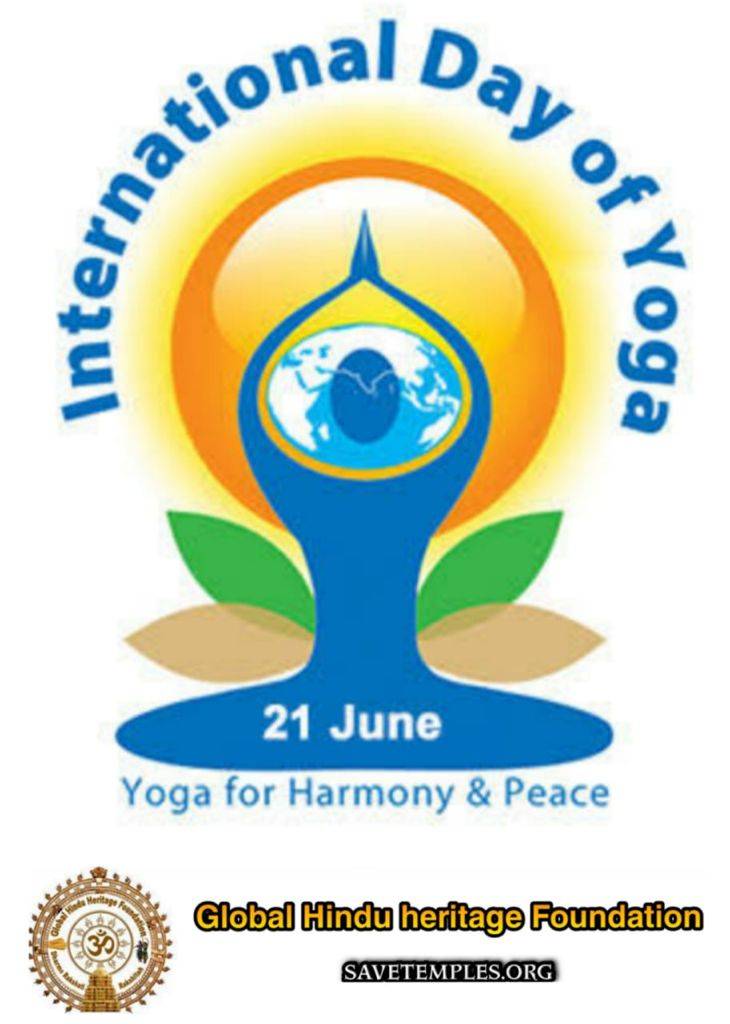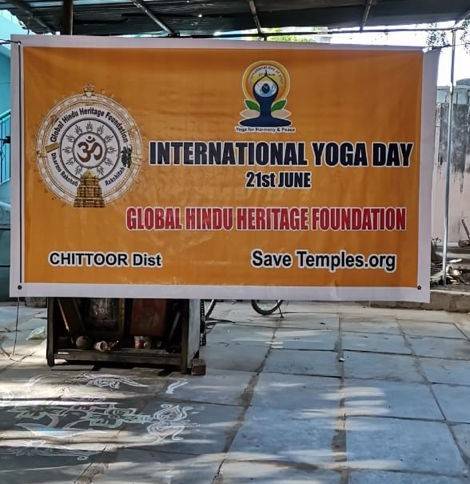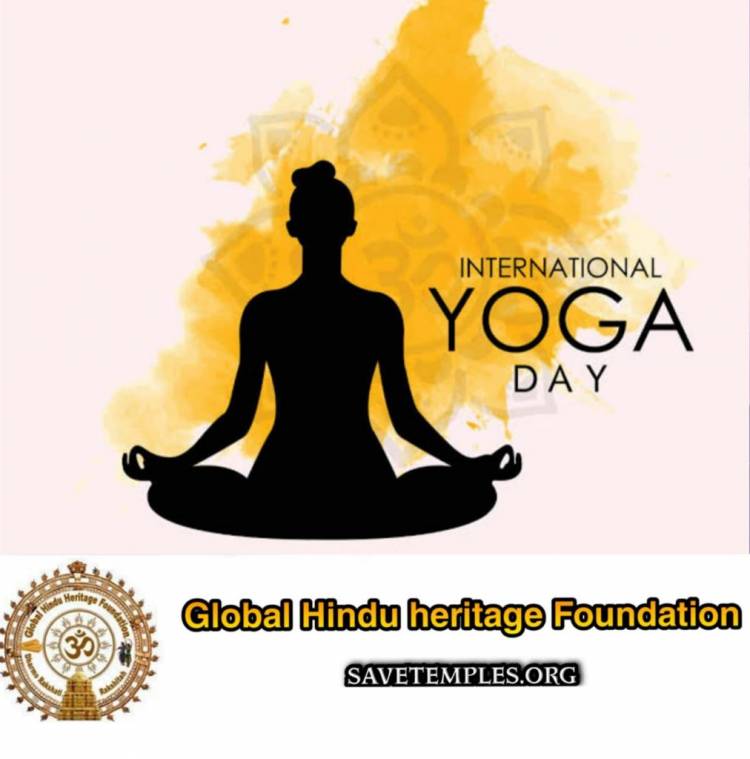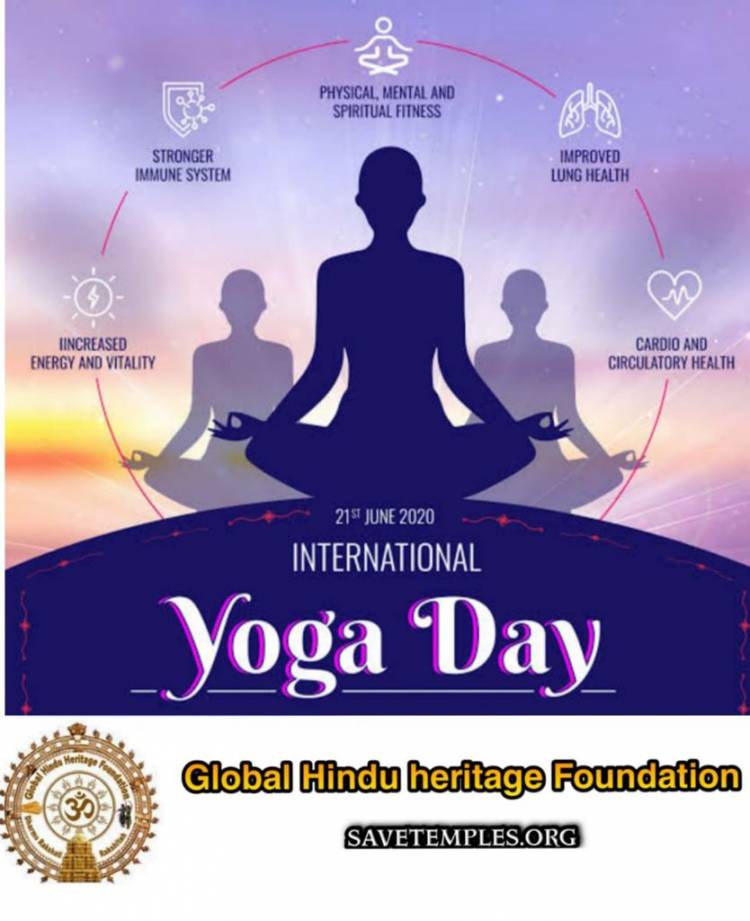Yoga Embodies Unity and Harmony for the Humanity Celebrating the 7th International Day of Yoga
 Prakasarao V Velagapudi, PhD
Prakasarao V Velagapudi, PhD
President, Global Hindu Heritage Foundation.
On this International Day of Yoga, I will try to address yoga, its relevance to the youth, its benefits, its role in bringing unity and harmony among individuals as well as in the universe, and the importance of ashtanga yoga – that is, the eight limbs of Patanjali Yoga. The theme of International Day of Yoga has been decided by the United Nations as “Yoga for well-being” recognizing its importance due to the Coronavirus pandemic.
India’s Prime Minister Narendra Modi during his address to the UN General Assembly in September 2014, had asked world leaders to adopt an international Yoga Day, saying “Yoga embodies unity of mind and body; thought and action; restraint and fulfillment; harmony between man and nature; a holistic approach to health and wellbeing. Yoga is not just about exercise; it is a way to discover the sense of oneness with yourself, the world, and the nature.
For millennia, our ancient Rishis have recognized the importance of controlling or subduing the mind in order to live a peaceful, harmonious, and unified life. Because the mind is the most difficult to restrain, control or silence.
Paramahansa Yogananda recognized the difficulty and compared the controlling mind with impossible incidents as follows:
“You may control a mad elephant;
You may shut the mouth of the bear and the tiger;
Ride the lion and play with the cobra;
By alchemy you may learn your livelihood;
You may wander through the universe incognito;
Make vassals of the gods; be ever youthful;
You may walk in water and live in fire;
But control of the mind is better and more difficult.”
If the mind is that difficult to control, what can be done to quell, still or silence the mind. Patanjali Yoga Sutras written sometime between 500 BCE and 400 BCE. It contains four chapters containing 195 Sutras (aphorisms). The whole book hinges on the second sutra “yogah citta-vṛtti-nirodhaḥ.”(“Yoga is the cessation of the fluctuations of the mind”). Yoga means of “joining the individual soul to the universal soul” or removing the barriers between the two souls to become one.
 Yoga establishes harmony between mind, body, and spirit. It is joining the inner and outer nature. A person who does not possess physical, mental, spiritual, and social well-being is a danger for himself and society as well.
Yoga establishes harmony between mind, body, and spirit. It is joining the inner and outer nature. A person who does not possess physical, mental, spiritual, and social well-being is a danger for himself and society as well.
“Yoga is that single universal principle which balances the entire universe. All elements, visible and invisible, as well as all stars, moons and sun systems, are entirely sustained by the balancing principle of Yoga.” Swami Maheshwarananda
Yoga and Meditation have many positive effects on physical and mental health, reduce stress and anxiety, improve educational achievements, mental growth, school performance and many such advantages.
According to Sri Ganapathy Sachchidananda Swamiji, “The word Yoga is derived from the Sanskrit word ‘yuj’. It means to unite or to join together. It means aligning the body with mind, and mind with the Atman (Self within), thus leading a comfortable and blissful life.” Swamiji says Yoga embodies the unity of body, mind, and spirit; within and without, thought and action; restraint and fulfillment; and harmony between man and nature. Yoga also means synchronization of one’s thoughts, words, and actions to create a sense of wholeness.
In Cambridge University Swami Vivekananda explained concisely the nature of Raja Yoga: “Yoga is the science by which we may stop Chitta from assuming or becoming transformed into several faculties. As the reflection of the moon on the sea is broken or blurred by the waves, so is the reflection of the Atman, the true Self, broken by the mental waves. Only when the sea is stilled to mirror like calmness, can the reflection of the moon be seen, and only when the “mind-stuff,” the Chitta, is controlled to absolute calmness, is the Self to be recognized.”
Edwin Bryant states that, to Patanjali, "Yoga essentially consists of meditative practices culminating in attaining a state of consciousness free from all modes of active or discursive thought, and of eventually attaining a state where consciousness is unaware of any object external to itself, that is, is only aware of its own nature as consciousness unmixed with any other object."
A study conducted by Yoga Journal and Yoga Alliance reveals that the number of yoga practitioners has increased to more than 36 million, up from 20.4 million in 2012. Also, thirty-four percent of Americans or 80 million people say they are likely to try yoga for the first time in the next 12 months. “What's fascinating is the data shows that those who practice and teach yoga have measurably better perceptions of their individual strength, balance, dexterity, and mental clarity versus non-practitioners," said Yoga Alliance Executive Director and COO, Barbara Dobberthien.
Mayo Clinic asks a question, “is yoga right for you?” It says, “It is if you want to fight stress, get fit and stay healthy”. Numerous studies have well documented the wealth of information on the health and spiritual benefits of yoga. Yoga credited with the reduction of stress and anxiety while at the same time it enhanced the mood and overall well-being. It helped reduce risk factors for chronic diseases, such as heart diseases and high blood pressure, alleviated chronic conditions such as depression, pain and insomnia. It is attributed to improved balance, flexibility in mind and body, range of emotions and strength. Benefits also include muscle strength and tone, improved respiration, energy and vitality, weight reduction, improved athletic performance and increased blood flow.
- The study conducted by Davidson at the University of Wisconsin revealed that consistent yoga practice led to a significant increase in the serotonin levels and a decrease in the levels of monoamine oxidase (an enzyme that breaks down neurotransmitters) and cortisol. He also reported that the left prefrontal cortex showed heightened activity in meditators, a finding that has been correlated with greater levels of happiness and better immune function. More dramatic left-sided activation was found in dedicated, long-term practitioners.
The NIH's Center for Complementary and Integrative Health says that yoga – like any exercise – "might improve quality of life; reduce stress; lower heart rate and blood pressure; help relieve anxiety, depression, and insomnia; and improve overall physical fitness, strength, and flexibility." The center also says "a carefully adapted set of yoga poses" may ease lower back pain.
School Yoga
 Jessica Mei Gershen, a certified yoga instructor who teaches yoga to children at Brooklyn Yoga Project and founder of Yoga for All Needs, recommends making yoga playful and fun for kids, whether in the classroom or at home. In her yoga classes, Gershen weaves in fun games and stories with positive themes like compassion, gratitude, and strength.
Jessica Mei Gershen, a certified yoga instructor who teaches yoga to children at Brooklyn Yoga Project and founder of Yoga for All Needs, recommends making yoga playful and fun for kids, whether in the classroom or at home. In her yoga classes, Gershen weaves in fun games and stories with positive themes like compassion, gratitude, and strength.
“Yoga is really effective because it’s so tangible. Learning physical postures builds confidence and strength as well as the mind-body connection,” Gershen says. She also has found that the effects of yoga go beyond physical fitness and also allow kids to build confidence and awareness beyond the classroom. “Through yoga, kids start to realize that they are strong and then are able to take that strength, confidence, acceptance, and compassion out into the world,” notes Gershen.
Yoga will help the youth to improve fitness and physical health, reduce stress and anxiety, improve optimism, improve focus, and school performance, improve self-esteem and body image, encourage creativity, improved attention span, improved memory, overall academic improvement, and develop discipline and self-regulation,
“If you practice yoga every day with perseverance, you will be able to face the turmoil of life with steadiness and maturity” Iyengar BKS. Similarly, Sadhguru Vasudev says, “Yoga means to be in perfect tune. Your body, mind and spirit and the existence are in absolute harmony. When you fine-tune yourself to a point where everything functions so beautifully within you, the best of your abilities will naturally flow out of you.”
In a recent book on yoga education in India, A. Balkrishna claims that “in a nutshell, yoga is a powerful medium for developing the personality of children and making them capable of facing the present-day challenges and problems” [p. 3]. In her review article, “Effect of Yoga on Mental Health in Children,” one of the world’s most prominent yoga researchers, Shirley Telles, concludes that yoga improves children’s physical and mental well-being . Similarly, the Harvard professor Sat Bir Khalsa finds that yoga in schools helps students improve resilience, mood, and self-regulation skills pertaining to emotions and stress. Thus, yoga is an important life skill tool for children and young people to cope with stress and self-regulation from a life-long perspective.
Research has concluded that Yoga's impact on physical and mental health has been established in ancient Indian literature as well as contemporary yoga literature. It appears that yoga would help you to develop self-esteem, self-disciple, self -development and self-reflection.
“Yoga means balance, harmony and unity. Universal balance, Harmony of body, mind and soul and Unity of the individual consciousness with the cosmic consciousness. The ancient science of Yoga readily equips humans to reinstate world peace, environmental sustainability, as well as harmony between individuals, communities, religions, and nations. In modern times, Yoga has unfortunately come to mean only physical exercise or posture, however that is only one aspect of this ancient science, the others are neglected.” Swami Mahesharananda
Yoga for the Special Child, developed by Sonia Sumar, is designed to enhance the natural development of children with disabilities. The gentle and therapeutic style of yoga can be used for both babies and children with disabilities. Yoga for the Special Child incorporates yoga poses to increase flexibility and strength with breathing and relaxation techniques to increase focus and reduce hyperactivity.
A healthy body and mind are important for the development of all children. At all grade levels, from preschool through high school, students have shown improved academic and behavioral performance when yoga has been introduced in the school. The Association for School Yoga and Mindfulness continues to advocate for the inclusion of students with disabilities in school yoga programs, emphasizing, once again, that physical activity (yoga, in this case) is for everybody.
Yama and Niyama
Yama gives momentum to the development of a disciplined society. Yama is basically concerned with the social behavior of an individual. It underlines the social code of conduct for an individual, whereas Niyama underlines the personal code of conduct for an individual. Today persons violating personal and social code of conduct are involved in various self-centered behaviors. They are basically concerned with their own selfish ends and have nothing to do with personal and social values. They are not able to think beyond their selfish ends. The result is what we are witnessing everywhere in society as social diseases and social evils like corruption, crime, cheating, violence, terrorism, rape, sexual harassment etc. our media are over flooded with such news and views. The application of Yama and Niyama can play a major role in eradicating these social evils.
As a part of Yoga training for school children, we should emphasize the importance of Yama and Niyamas along with other limbs of Yoga. Yama teaches us to learn to believe and practice non-violence, truthfulness, non-stealing, celibacy, and non-possessiveness. Through Niyamas, they learn about cleanliness and purity of thought, word, and deed; contentment, inner abundance, and happiness; austerity to destroy impurities; Svadhyaya to find out the relationship between you and the divine; and surrender yourself to the Supreme Soul.
Super Yoga is being taught in the schools and it is being used to bring discipline and balance. It also improves mental energy, intelligence and creativity, memory, class participation, academic performance, behavior, social skills, and concentration.
A 2011 study by Harvard-affiliated researchers at Massachusetts General Hospital (MGH) substantiated this. Meditation is associated with a thicker cerebral cortex and more gray matter. These are the parts of the brain linked to memory, attention span, decision-making, and learning. Thus, meditation is a means to increase brain power.
Samyama Meditation
In the Yoga Sutras, samyama does not appear until Book Three, Sutra 3.4, where Patanjali explains samyama as occurring when the last three of yoga’s Eight Limbs are practiced simultaneously. These limbs are dharana (concentration), dhyana (meditation), and samadhi (allowing one’s concept of “self” to be dissolved).
The fusion of Dharana, Dhyana and Samadhi is Samyama – the path to Kaivalya.
In the Yoga Sutras, samyama does not appear until Book Three, Sutra 3.4, where Patanjali explains samyama as occurring when the last three of yoga’s Eight Limbs are practiced simultaneously. These limbs are dharana (concentration), dhyana (meditation), and samadhi (allowing one’s concept of “self” to be dissolved). According to Sutra 3.5, “by the mastery of samyama comes the light of knowledge,
Samadhi literally means "putting together, joining, combining with, union, harmonious whole, trance".
Samadhi is oneness with the subject of meditation. In Samadhi, there is no distinction between the actor of meditation, the act of meditation and the subject of meditation. Samadhi is that spiritual state when one's mind is so absorbed in whatever it is contemplating on, that the mind loses the sense of its own identity. The thinker, the thought process, and the thought fuse with the subject of thought. There is only oneness, samadhi.
All three (Dhyana, Dharana and Samadhi) practiced on a particular object or subject are called Samyama by Patanjali.
Samyama (the progression of dharana, dhyana, samadhi) constitute the final 3 of the ashtau angani (8 limbs), the antaranga or internal limbs, which are increasingly deep and silent states of (usually) still, seated meditation. The 1st 5 limbs, or baharanga, the external limbs, include asana, pranayama and pratyahara in order to prepare the attitude, body, breath, and energy (prana) flow for samyama. One does not and cannot practice the physical sadhana (techniques) like drishti or breath control in asana (which is different from pranayama) concurrently with samyama. They are different tools for different purposes. The baharanga precedes the antaranga. Do not confuse the sequence of the ashtanga.
The more advanced we are, the more detached we will be with the results. Inner silence comes from within. If we practice the last three limbs, we will have all other five limbs manifest automatically. Samyama greatly strengthens our presence in the silence of pure bliss consciousness. It stimulates the nervous system to purify and open experience the bliss within. If we cannot stop thinking, contemplating, and feel the physical presence in meditation, we are not ready for Samyama. We should experience inner silence in order to enter the samadhi. Inner silence is also called yoga Nidra, stillness, samadhi, pure bliss consciousness, sat-chit-ananda, void, emptiness and so on.
Individual Transformation is essential
 individual and society are complementary and supplementary to each other. Yoga plays a pivotal role in establishing the purposeful life among youth who can shape the future of the society. Yoga helps us to become physically and mentally healthy. Without healthy individuals, a healthy society is not possible. Without a healthy society, humanity cannot be at peace. The healthy and transformed individual, in turn, will build up healthy society without any discrimination of caste, creed, colors etc. The practice of Yama Niyamas makes them purify and clean. Therefore, the desirable personal and ethical values help to purify themselves and to transform society. The individual is constantly engaged in examining one’s values. One must recognize that the practice of Yama and Niyama values bring integrity, contentment and peace and bliss; while indifference to these values bring confusion, conflicts, miseries, and misfortunes to themselves and the society. Therefore, the application of yoga for social well-being and social transformation is essential. Practice of Yoga principles is even more important to live as a productive citizen of the country. Ajay Bharadwaj stated that, “ When the sun of yoga will shine over the horizon of the world and society today, the social evils, all the immoral and inhuman behavior will disappear, and the dream of a peaceful, prosperous, blissful, and transformed society will be fulfilled. Yoga, indeed, immerses a person into the essence of Satyam-Shivam-Sundaram and Sat-chit-Ananda (Truth-Bliss-and Consciousness) and therefore, the society having such persons is like a heaven on the earth.”
individual and society are complementary and supplementary to each other. Yoga plays a pivotal role in establishing the purposeful life among youth who can shape the future of the society. Yoga helps us to become physically and mentally healthy. Without healthy individuals, a healthy society is not possible. Without a healthy society, humanity cannot be at peace. The healthy and transformed individual, in turn, will build up healthy society without any discrimination of caste, creed, colors etc. The practice of Yama Niyamas makes them purify and clean. Therefore, the desirable personal and ethical values help to purify themselves and to transform society. The individual is constantly engaged in examining one’s values. One must recognize that the practice of Yama and Niyama values bring integrity, contentment and peace and bliss; while indifference to these values bring confusion, conflicts, miseries, and misfortunes to themselves and the society. Therefore, the application of yoga for social well-being and social transformation is essential. Practice of Yoga principles is even more important to live as a productive citizen of the country. Ajay Bharadwaj stated that, “ When the sun of yoga will shine over the horizon of the world and society today, the social evils, all the immoral and inhuman behavior will disappear, and the dream of a peaceful, prosperous, blissful, and transformed society will be fulfilled. Yoga, indeed, immerses a person into the essence of Satyam-Shivam-Sundaram and Sat-chit-Ananda (Truth-Bliss-and Consciousness) and therefore, the society having such persons is like a heaven on the earth.”
Yoga is for the humanity
- works on one’s body, mind, and soul. Therefore, it is known as the global art. When our body, mind and soul are healthy and harmonious, we will bring health and harmony to the world-not by withdrawing from the world but by being a healthy living organ of the body of humanity. Therefore, yoga is for the whole world and humanity. Human suffering is the same. We all are humans. Everyone needs physical, mental, and spiritual wellbeing for a peaceful, prosperous, and blissful life. And yoga in fact, serves this purpose. Irrespective of the nation and religion, problems facing the body and mind are the same. Diseases and sufferings know no caste, religion or nation, and yoga is given to cure those diseases.
Maharshi Patanjali describes yoga as Sarva Bhauma, that means Universal. Universal monarch
Maharshi Patanjali in Yogasutra 2-31 says:
“Jatides kala samyama vachchhinnah sarvbhauma mahavratam”
- great vow of restraint is universal to all earthly objects unbound by the conditions of time, place, birth lineage or family.” The practice of five restraints (Yamas) --- non-violence, truthfulness, non-stealing, devotion to Divine and study or Divine-study, non-attachment --- should be applied universally regardless of religion, time, or the country. Thus, yoga is a Universal culture, or it has Universal appeal? It was evident when 175 nations in the United Nations voted to declare June 21st as International Day of Yoga. This year is even important to observe due to the pandemic that created havoc among people across the globe creating stress, anxiety, depression, isolation, and helplessness. Thus, yoga is meant for the development of the whole of mankind on the physical, mental, and spiritual levels. Yoga is playing a significant role in rehabilitation of Covid patients and people in quarantine. It is yoga which can give permanent solutions to these global problems.
Swami Shivananda says “Today in this age of atomic armament, racial hatred, intolerance and distrust, the moral, ethical and cultural refinement of the individual personality upon a world-wide scale is to be realized first and foremost. For, the prime and fundamental unit of all wider groups like class, race, nation, and human society the world over is the individual man. This is not an impossible proposition, for the divine exists in all beings and it is an integral part of every individual consciousness. The method to draw it out is right and true yoga or spiritual education” .
Sri Ram Sharma Acharya observes “The dream of the creation of a divine society for the Universal peace, prosperity and bliss can come true only when each one develops divinity within oneself and become a divine and pious human being by refining his thoughts through yoga and spirituality, otherwise there seems to be no other way of permanent and real peace and bliss in the world” .
Maharshi Aurobindo very Beautifully Remarks “The yoga we practice is not for ourselves alone, its aim is to work out the will of the divine in the world, to effect a spiritual transformation and to bring down a divine nature and a divine life into the mental, vital and physical nature and life of humanity. Its object is not personal Mukti or liberation, although Mukti is necessary condition of the yoga, but the liberation and transformation of the whole human being” .
Swami Ramdev argues “All persons in the world want peace and happiness. All the nations of the world agree on this point that peace should be established in the world. Is there a path which can lead to social and global peace and harmony? Is there a way to achieve complete happiness, peace, and bliss in life? This is the path of ashtanga yoga propounded by the great sage Patanjali. This is not a creed, belief, or sect; it is a complete method of living life. If the people all over the world are really serious about it that peace must be established in the world, its only solution is- observance of Ashtanga yoga. It is only through eight-limbed (ashtanga) yoga that personal and social harmony, physical health, mental peace and spiritual bliss can be realized” .
Dr. H.R. Nagendra says “Yoga is a science of holistic living. It is Universal in its approach and applicable to all human beings irrespective of sex, age, caste, creed, or religion. Anyone who wants to raise himself from the lowest level to the highest level of human achievement can take to yoga”.
Yoga teaches us to practice eight limbs so that we will rise above all narrowmindedness, develop the attitude of non-violence, create love toward mankind , relinquish the hatred toward others and look at the whole world as Vasudhaiva Kutumbakam. It would pave the way for a healthy, peaceful, harmonious, and congenial life. Yoga will garner the right attitude and help us to tap the potential to transform the individuals, families, communities, societies, and the whole of humanity. Let us remember on this International Day of Yoga, how yoga can play a pivotal role in uniting, unifying, and coalescing the humanity by breaking all the barriers created to live in peace and harmony.
Global Hindu Heritage Foundation organised yoga session on 21st morning in Tirupati by K. Reddappa abd K. Subbanna.















 Urgent support needed for Bangladesh Hindus
Urgent support needed for Bangladesh Hindus 







